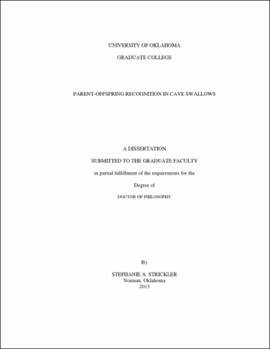| dc.description.abstract | Natural selection favors investment in genetic relatives over giving such aid indiscriminately. Parental care is often easily directed only towards genetic relatives, but under some circumstances, this task can be problematic. For example, in systems where unrelated young are commonly mixed with genetically related offspring (through such mechanisms as brood parasitism and extrapair fertilization), or when young are mobile, there is increased risk of misdirecting parental care. In such cases, parents may evolve mechanisms for recognizing their own young. The colonial cave swallow (Petrochelidon fulva) presents an outstanding opportunity for testing predictions about the evolution of parent-offspring recognition in response to the risk of misdirected parental investment. In breeding colonies, offspring are known to mix through brood parasitism; extrapair young are also likely. After juveniles leave the nest, they form mixed-family flocks, crèches, and remain dependent on their parents for food. Provocatively, the nestlings are known to develop idiosyncratic white facial plumage patterns, a feature that has been suggested to provide a visual signature system for parent-young recognition in cliff swallows. The open structure of many cave swallow nests, unlike those of cliff swallows, facilitates observation (and filming) of parental feeds to chicks. In the following chapters, I examine how likely cave swallow parents are to encounter young unrelated to them and whether they have evolved strategies to reduce the risk of caring for unrelated young. Chapter 1 details a series of behavioral studies designed to determine whether parents recognize their own offspring and, if so, when and how such abilities develop. Temporary nestling transfer experiments showed that parents bias feedings toward a chick from their own nest vs. one from another nest when chicks are older (18 days) but not when they are about halfway through the nesting phase (10 days). To examine the mechanism by which parents learn to identify their young, I also cross-fostered half-broods of young chicks between nests and tested parental recognition of older chicks. The results of the behavioral experiments in the cross-fostering nests suggested that parents learn characteristics of the young present in their nest, perhaps in preparation for finding offspring in the crèche after fledging. However, such a mechanism would not allow parents to identify and reject young that arrive in their nest via extrapair matings or conspecific brood parasitism. Chapter 2 examines whether adults are able to reduce the costs associated with hosting parasitic eggs and chicks by recognizing and rejecting foreign eggs. I analyzed egg shape, size, and spot pattern from photographs of cave swallow clutches and found evidence that egg characteristics differed among clutches, and so contain information that could be used to reject parasitic eggs. However, experimental egg transfers showed that cave swallows rarely ejected eggs from their clutches, and hatching failure was no more likely for eggs transferred into clutches than for the hosts' own eggs. Thus, cave swallows do not appear to have a mechanism to avoid caring for eggs deposited in their nests by brood parasites. Chapter 3 addresses the possibility that the striking variation in facial plumage present in young cave swallows is used by parents in their efforts to recognize their own offspring. Despite the provocative result in an earlier study, which showed that human subjects can reliably identify individual nestlings from photographs in a closely related species, the cliff swallow, this is the first study to pair molecular methods of identifying nestlings unrelated to their nestmates with quantitative analysis of their facial markings. A cross-fostering experiment revealed that genetic effects far outweighed environmental effects on nestling facial patterns, although neither of these effects was significant. Together, these studies show that cave swallows have evolved to reduce the risk of misdirecting parental care at some stages, (post-fledging crèches), but not others (brood parasitism or extrapair young) and suggest that visual traits, perhaps in tandem with vocal cues, may facilitate parental recognition of young. | |
